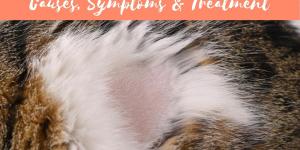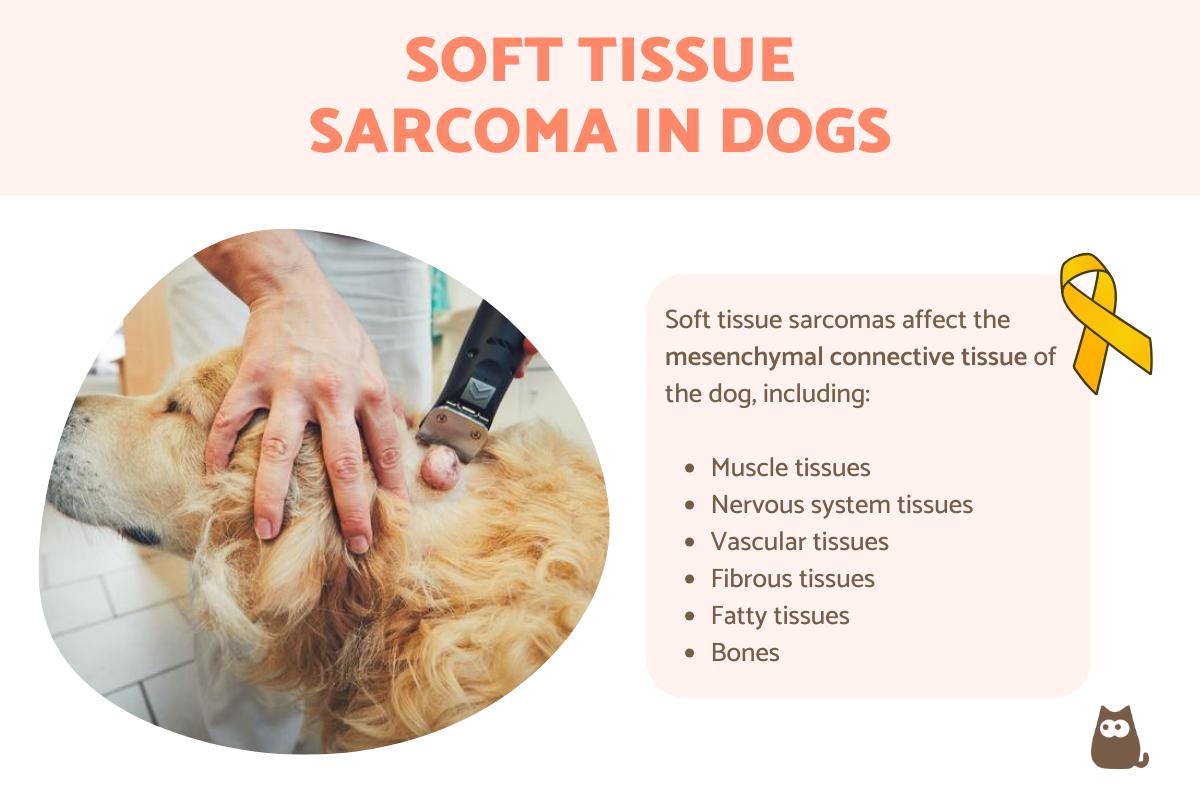Soft Tissue Sarcoma in Dogs



See files for Dogs
As with human beings, companion animals can suffer from various types of cancer. These can appear on almost any part of the body and present with varying symptoms, often dependent on the location. One of the most common symptoms is the presence of a lump, although it is important to note that lumps can be varying types of neoplasms, not all of which are malignant. Soft tissue sarcoma is a type of cancer which presents on soft tissues such as the skin and organs. It is a malignant type of tumor and, unfortunately, is a common canine cancer.
At AnimalWised, we understand soft tissue sarcoma in dogs by looking at their symptoms and treatment. We also look at possible causes and risk factors for certain dogs.
What is a soft tissue sarcoma in dogs?
A soft tissue sarcoma is an abnormal growth of embryological mesenchymal tissue. This is a term for various types of connective tissue, including bones, cartilage and fat. Since the type of soft tissues varies, the clinical symptoms vary accordingly. They are a malignant form of sarcoma, meaning they are a type of cancer and can seriously affect the health of a dog.
Statistically, the vast majority or sarcomas are seen in middle-aged to senior domestic dogs. Although the symptoms can vary, they all share the common feature of a neoplasm. These are growths of cells which present on the soft tissue in the form of localized inflammation, known as a tumor. The tumors of a soft tissue sarcoma can vary in size.
Because the tumors originate in the mesenchymal connective tissue of the dog, soft tissue sarcomas develop mainly in the following areas:
- Muscle tissues
- Nervous system tissues
- Vascular tissues
- Fibrous tissues
- Fatty tissues
- Bones
Although the bone is not considered soft tissue, it is possible for the sarcoma to spread. This is a result of the process known as metastasis which is a serious and life-threatening complication.
Types of soft tissue sarcomas in dogs
The types of tissues do not necessarily determine the type of sarcoma in dogs, but not all types will be able to develop in the same places. However, they are all malignant, meaning they are considered types of canine cancer. The most frequent soft tissue sarcomas in dogs are categorized as:
- Fibrosarcoma: a malignant tumor that forms in fibrous tissue and can appear anywhere in the body.
- Neurofibrosarcoma: rare malignant tumors that are located in the peripheral nervous system.
- Myxosarcoma: a malignant tumor of fibroblast origin capable of producing metastasis.
- Leiomyosarcoma: an aggressive sarcoma that appears in areas of smooth muscle tissue, such as the uterine or gastrointestinal linings.
- Rhabdomyosarcomas: a malignant tumor that appears in skeletal muscle.
The case of malignant fibrous histiocytoma is subject to debate about whether or not it should be included in this group of neoplasms.
Symptoms of soft tissue sarcoma in dogs
The symptoms of soft tissue sarcoma are varied, largely depending on the area in which the tumor appears. However, all soft tissue sarcomas present as a slow-growing neoplasm that appear almost anywhere on the body. They often have a smooth, but firm consistency with an irregular, lobulated appearance and firmly attached to the underlying tissue and/or the skin.
The different clinical signs that are observed will depend on the anatomical area where the tumor has developed. For example, if the dog presents with a myosarcoma situated in a muscle of the dog's leg, pain and lameness may be observed when walking. In the case of neurofibrosarcomas (in the brain tissue), there will be signs of neurological alteration.
However, there are general symptoms of sarcoma in dogs which can lead us to suspect they may suffer from this problem:
- Inflamed lumps or bumps
- Loss of weight and appetite
- General discomfort
- Fatigue
- Pain
- Poor condition of coat
- Hair loss
- Vomiting and/or diarrhea
If you suspect that your dog's health status is compromised, we recommend that you go to your veterinarian as soon as possible. As many of these symptoms of soft tissue sarcoma in dogs are shared by other conditions, they will need to carry out a differential diagnosis. Below is a picture of soft tissue sarcoma in a dog after surgical incision has exposed the tumor.

Causes of soft tissue sarcoma in dogs
It is not easy to define the causes of soft tissue sarcoma in dogs. Not only are the causes varied, but they are often indeterminable. Especially those which affect the soft tissues, tumors are generally believed to have a hereditary genetic influence. This can be attributed to certain breeds or specific family lineages. Some breeds predisposed to developing soft skin sarcoma are the German Shepherd, Boxer and Golden Retriever.
Environmental causes are unlikely to influence the development of this tumor or, at least, the research is insufficient to understand a definite cause. Some risk factors in developing sarcoma are poor diet and increased stress levels. This means providing your dog's basic needs and ensuring a calm environment can help avoid various health problems, including cancers.
Treatment of soft tissue sarcoma in dogs
The most effective current treatment of sarcoma in dogs is the surgical removal of the tumor. Whether surgery is an option will depend on the location, state and phase of the neoplasm at the time of diagnosis. Although surgery is the most important initial treatment, in many cases it is necessary to provide supportive treatment in the form of chemotherapy and/or radiotherapy.
Five different grades of soft tissue sarcoma have been postulated: I, II, III, IV and V. These vary according to the stage of development of the cancer.
The fifth is known as the recurrent stage, due to the fact the sarcoma reappears after treatment. The recurrent sarcoma can appear in a place near to the original tumor site, but can also appear in tissue far from it. This means treatment of the newly developed sarcoma will depend on its new location.
In many cases, chemotherapy may be used prior to surgery so that the size of the tumor may be reduced. When the cancer has metastasized, it is possible chemotherapy will be used as a form of palliative care for the dog to extend their life expectancy.
If the total removal of the tumor has not been possible during surgery, a second surgical intervention may be required. This is to try to remove the entire neoplasm or any remnants and avoid regrowth. In cases where secondary surgical intervention cannot be performed due to medical reasons, radiotherapy may be used to control residual disease and facilitate removal.
Home remedies for soft tissue sarcoma in dogs
There are some reports of alternative therapies for treating cancer in dogs. However, these treatments or home remedies are not sufficiently backed by scientific study. Implementing them in place of medical intervention can be fatal for the dog. It is possible supportive therapies may be administered alongside veterinary medical treatment, but this should be approved by the veterinarian before doing so.

Life expectancy of dogs with soft tissue sarcoma
We cannot give a life expectancy for any individual dog as this will need to be determined by the veterinarian. However, once diagnosis is achieved, the grade is considered the most important factor in the dog's prognosis[1].
The grade system means that dogs in the lowest grade (grade I) are the least likely to have cancer recur. Dogs with grade V soft tissue sarcoma have the lowest life expectancy. In addition to the grade, other factors will influence the ability for the dog to recover, including underlying or secondary health problems.
Since soft tissue sarcoma in dogs is most common in older or senior dogs, it is possible palliative treatment will be implemented. This is because the chance of recovery might be low. Also, cost of surgery and other veterinary treatment will be a factor for many dog guardians.

This article is purely informative. AnimalWised does not have the authority to prescribe any veterinary treatment or create a diagnosis. We invite you to take your pet to the veterinarian if they are suffering from any condition or pain.
If you want to read similar articles to Soft Tissue Sarcoma in Dogs, we recommend you visit our Other health problems category.
1. Dennis, M. M., et al. (2011). Prognostic Factors for Cutaneous and Subcutaneous Soft Tissue Sarcomas in Dogs. Veterinary Pathology, 48(1), 73-84.
https://journals.sagepub.com/doi/full/10.1177/0300985810388820







